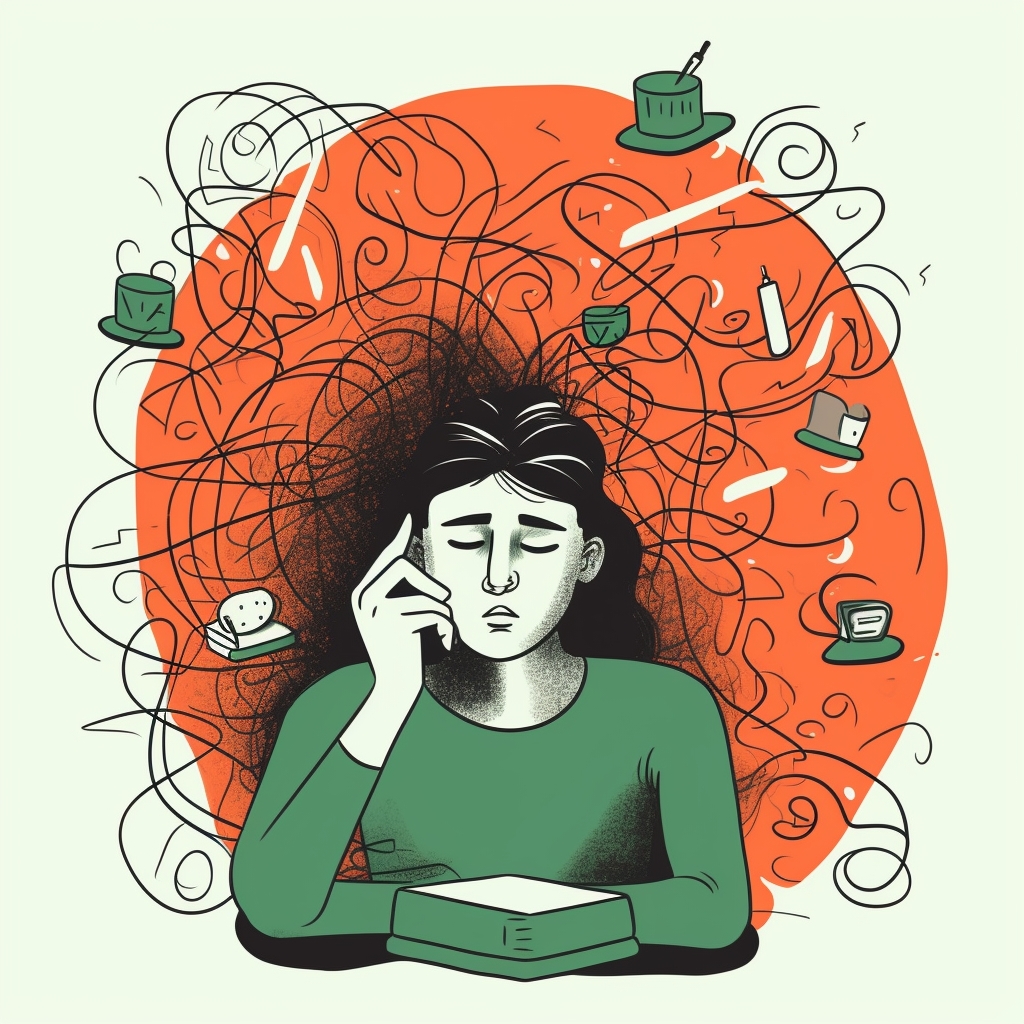What is OCD? | Symptoms, Types, and Diagnostic Criteria

Did you know that millions of people are dealing with Obsessive-Compulsive Disorder (OCD) every day? It’s crucial to grasp the significance of this condition and learn more about it. In this post, we’ll dive into the world of OCD, exploring its effects and shedding light on its importance. From understanding the common symptoms to exploring different types of OCD, diagnostic criteria, and available treatments, we’ll cover it all. By the end, you’ll have a solid understanding of OCD, enabling you to offer support and empathy to those who are affected. Join us as we explore this informative blog, delving into the practical aspects of OCD and its impact on individuals’ lives.
What is OCD?
OCD, or Obsessive-Compulsive Disorder, is an anxiety disorder characterized by recurring and distressing thoughts, known as obsessions, along with repetitive behaviors or mental acts, referred to as compulsions. The meaning of OCD lies in the intense and intrusive nature of these obsessions and the compelling need to perform specific rituals or behaviors to alleviate anxiety. Individuals with OCD may experience persistent doubts, fears, or worries that intrude upon their daily lives. These obsessions and compulsions can significantly interfere with daily functioning, causing distress and impairing overall well-being.

Symptoms of OCD
Obsessive-Compulsive Disorder (OCD) is characterized by a variety of symptoms, which can include the following examples of OCD behaviors:
- Common Obsessive Thoughts
- OCD contamination or persistent fears of germs
- Intrusive thoughts related to harm, violence, or aggression
- Excessive concerns about order, symmetry, or exactness
- Disturbing religious or sexual obsessions
- Unwanted thoughts of causing harm to oneself or others
- Typical Compulsive Behaviors
- Excessive hand washing or cleaning rituals; using sanitizers or disinfectants, repeatedly washing or cleaning personal belongings or living spaces.
- Avoiding specific places or objects, or wearing protective clothing.
- Compulsive checking of doors, locks, or appliances
- Counting, tapping, or repeating specific words or phrases
- Arranging items in a precise manner or seeking symmetry
- Mental rituals, such as praying or repeating certain phrases

While these symptoms of OCD are primarily experienced by adults, it is important to note that a variety of OCD symptoms can also occur in infants, children, and teenagers. Some possible manifestations include:
- Repetitive behaviors or rituals specific to their developmental stage
- Age-appropriate obsessions related to school, performance, or social situations
- Excessive reassurance-seeking behaviors from parents or caregivers
- Avoidance of certain activities or situations due to fears or anxieties
- Interference with academic performance, relationships, or daily routines
- Emotional distress or irritability when unable to engage in compulsions
- Impact on peer interactions, self-esteem, and overall well-being
Understanding the differences in OCD symptoms across age groups is crucial for accurate diagnosis, intervention, and support tailored to the unique needs of individuals at different stages of life.
| Read more: Symptoms of ROCD
Impact of OCD on Daily Life
OCD has significant effects on an individual’s daily life, leading to various challenges and disruptions. Here are some key impacts:
- Interference with Daily Activities
- Time-consuming rituals that consume a significant portion of the day
- Difficulty concentrating on tasks or responsibilities due to intrusive thoughts
- Impaired performance at work, school, or other daily activities
- Emotional Distress and Anxiety
- Persistent feelings of anxiety, fear, or distress associated with obsessive thoughts
- Heightened stress levels when unable to perform compulsive behaviors
- Negative impact on mood, well-being, and overall quality of life
- Strained Relationships
- Difficulties in maintaining healthy relationships due to OCD-related behaviors
- Social withdrawal or avoidance of social activities and gatherings
- Increased conflicts or misunderstandings with family, friends, or partners
- Impaired Productivity and Achievement:
- Reduced productivity and efficiency due to time-consuming rituals or repetitive behaviors
- Challenges in meeting academic or professional goals
- Limited opportunities for personal growth and development
- Financial Burden
- Excessive spending on items related to obsessions or compulsions
- Costs associated with seeking professional help, therapy, or medication
- Impact on Self-esteem and Self-image
- Negative self-perception due to the presence of obsessive thoughts and compulsive behaviors
- Feelings of shame, guilt, or embarrassment related to OCD symptoms
- Limited self-confidence and diminished sense of self-worth
Types of OCD

OCD can present in various forms, with different types or subtypes such as:
A. Relationship OCD (ROCD)
- Characterized by obsessive doubts and uncertainties regarding romantic relationships
- Excessive preoccupation with the quality, compatibility, or faithfulness of the relationship
- Compulsions may involve seeking reassurance, constantly analyzing interactions, or avoiding intimacy
B. Pure OCD (Primarily Obsessional OCD)
- Involves predominantly intrusive thoughts or obsessions without visible compulsive behaviors
- Intrusive thoughts may revolve around disturbing themes such as harm, illness, or morality
- Individuals often engage in mental rituals, such as mental reviewing or seeking mental reassurance
C. OCD with Intrusive Thoughts
- Includes subtypes such as Harm OCD, Sexual OCD, Contamination OCD, and Religious OCD
- Intrusive thoughts related to causing harm to oneself or others, explicit or unwanted sexual thoughts, excessive concerns about cleanliness or germs, or obsessions related to religious beliefs
- Compulsions can vary depending on the specific subtype and may involve avoiding triggers or seeking reassurance
D. Other Recognized Subtypes or Manifestations
OCD can present in various other forms, including but not limited to:
- Symmetry and Ordering OCD: Obsessions and compulsions related to arranging, organizing, or aligning objects in a particular way
- Hoarding OCD: Persistent difficulty discarding or parting with possessions, leading to cluttered living spaces
- Body Dysmorphic OCD: Preoccupation with imagined or minor flaws in one’s appearance, leading to excessive grooming or seeking reassurance
- Sensory OCD: Obsessions or compulsions related to specific sensory experiences, such as touching, tapping, or repetitive sounds
Causes and Risk Factors of OCD

The exact causes of OCD are not fully understood, but research suggests a combination of factors that contribute to its development. Here are some recognized causes and risk factors:
- Biological Factors
- Abnormalities in brain structure or functioning, particularly in areas associated with decision-making, fear, and anxiety
- Dysregulation of certain neurotransmitters, such as serotonin, dopamine, and glutamate, which play a role in mood and behavior
- Genetic Predisposition
- Family history of OCD or other related mental health disorders increases the likelihood of developing OCD
- Specific genes and variations have been identified as potential risk factors, although the genetic contribution to OCD is complex and not fully determined
- Environmental Influences
- Childhood trauma or stressful life events, such as abuse, loss, or significant transitions, may contribute to the development of OCD
- Environmental factors, including certain infections, can trigger or exacerbate symptoms in individuals with a genetic predisposition
- Neurochemical Imbalances
- Imbalances in brain chemicals, particularly serotonin, have been associated with OCD
- Disruptions in the serotonin system can impact mood regulation and contribute to obsessive thoughts and compulsive behaviors
OCD Test and Diagnosis
Accurate diagnosis of OCD involves assessing symptoms and meeting specific diagnostic criteria. Here’s an overview of the diagnostic process and the tools used for diagnosis:
- Diagnostic Criteria for OCD
- The diagnostic criteria for OCD are outlined in the Diagnostic and Statistical Manual of Mental Disorders (DSM-5), a widely used manual for mental health professionals.
- The criteria include the presence of obsessions, compulsions, or both, which cause distress, consume a significant amount of time, and significantly interfere with daily functioning.
- Screening Tests and Assessment Tools
- Clinicians may use various screening tests or questionnaires to aid in the assessment and diagnosis of OCD.
- The Yale-Brown Obsessive Compulsive Scale (Y-BOCS) is a commonly used tool to assess the severity and nature of OCD symptoms.
- Other assessment tools, such as the Obsessive-Compulsive Inventory (OCI) or the Padua Inventory, may be used to further evaluate specific symptoms and their impact.
- Clinical Evaluation and Interviews
- A comprehensive clinical evaluation, including a detailed psychiatric history and interviews, is essential for diagnosing OCD.
- The clinician will assess the nature, frequency, and severity of obsessive thoughts and compulsive behaviors, as well as their impact on daily life.
- The evaluation may also involve ruling out other medical or psychiatric conditions that may present with similar symptoms.
The diagnostic process involves open and honest communication between the clinician and the individual experiencing symptoms. Sharing personal experiences, thoughts, and behaviors is crucial for accurate diagnosis and developing an appropriate treatment plan.
OCD Treatment Options

Effective treatment approaches for OCD include therapy-based interventions and medication options. Here are some commonly utilized treatments:
Therapy-Based Approaches
- Cognitive Behavioral Therapy (CBT):
- CBT is a widely recognized and evidence-based treatment for OCD. It aims to identify and modify irrational thoughts and beliefs (cognitive restructuring) that contribute to obsessions and compulsions.
- CBT also includes behavioral techniques to gradually reduce compulsive behaviors through exposure to triggers and prevention of accompanying rituals (exposure and response prevention).
- Exposure and Response Prevention (ERP):
- ERP is a specific form of CBT that focuses on gradually exposing individuals to situations that trigger their obsessive thoughts, while simultaneously refraining from engaging in the associated compulsive behaviors.
- Through repeated exposures, individuals learn to tolerate anxiety and resist the urge to perform rituals, leading to a reduction in OCD symptoms.
- Acceptance and Commitment Therapy (ACT):
- ACT combines cognitive and behavioral techniques with mindfulness and acceptance strategies. It helps individuals develop psychological flexibility by accepting unwanted thoughts and feelings while engaging in behaviors consistent with their personal values.
- ACT aims to reduce the interference of OCD symptoms in individuals’ lives, fostering a more meaningful and fulfilling life despite the presence of obsessive thoughts.
OCD Medication Options
- Selective Serotonin Reuptake Inhibitors (SSRIs)
- According to the National Institute of Mental Health (NIMH), SSRIs are a class of antidepressant medications commonly prescribed to treat OCD.
- Examples of SSRIs include fluoxetine (Prozac), sertraline (Zoloft), and fluvoxamine (Luvox).
- These medications work by increasing the levels of serotonin, a neurotransmitter associated with mood regulation, which can help alleviate OCD symptoms.
- Other Medication Considerations
- In some cases, other types of antidepressants, such as tricyclic antidepressants (TCAs), may be prescribed if SSRIs are ineffective or not well-tolerated.
- Antipsychotic medications may be used as adjunctive therapy for severe or treatment-resistant OCD cases.
- The specific choice of medication, dosage, and duration should be determined by a qualified healthcare professional, considering individual needs and potential side effects.
Managing OCD

In addition to seeking professional help, there are several coping strategies and lifestyle changes that can assist individuals in managing Obsessive-Compulsive Disorder (OCD). Here are some tips to consider:
- Psychoeducation: Learn more about OCD, its symptoms, and treatment options. Understanding the full form of OCD can help reduce anxiety and provide a sense of control.
- Support Network: Seek support from friends, family, or support groups. Sharing experiences and receiving understanding can be invaluable in managing OCD.
- Stress Management: Practice stress-reducing techniques such as deep breathing, meditation, or mindfulness exercises to alleviate anxiety and promote relaxation.
- Healthy Lifestyle: Maintain a well-balanced diet, engage in regular physical exercise, and ensure sufficient sleep. A healthy lifestyle can positively impact mental well-being.
- Routine and Structure: Establish a structured daily routine to provide a sense of predictability and stability. This can help manage OCD symptoms and reduce anxiety.
- Gradual Exposure: Consider gradually exposing yourself to situations that trigger OCD symptoms. With the guidance of a mental health professional, gradually facing fears can help reduce anxiety and build resilience.
- Self-Care: Engage in activities that bring you joy and relaxation. Take time for OCD self-care and engage in hobbies or practices that promote overall well-being.
- Avoidance Strategies: Identify and challenge avoidance behaviors. While avoidance may provide temporary relief, it can reinforce OCD symptoms in the long run. Gradual exposure to triggers is often more beneficial.
- Journaling: Keep a journal to track triggers, obsessions, and progress. This can help identify patterns, monitor symptom severity, and provide insights for therapy.
Remember!
…everyone’s experience with OCD is unique, and what works for one person may not work for another. It’s essential to consult with a mental health professional who can provide personalized guidance and support in developing OCD coping strategies tailored to your specific needs.
HealWiser’s Last Piece of Advice
Living with Obsessive-Compulsive Disorder (OCD) can be challenging, but with the right support and strategies, individuals can manage and improve their quality of life.
Don’t hesitate to reach out for help. Whether it’s therapy, medication, or a combination of approaches, there are treatment options available that can help you manage your OCD symptoms. Remember, you are not alone, and there is hope for a brighter future.





